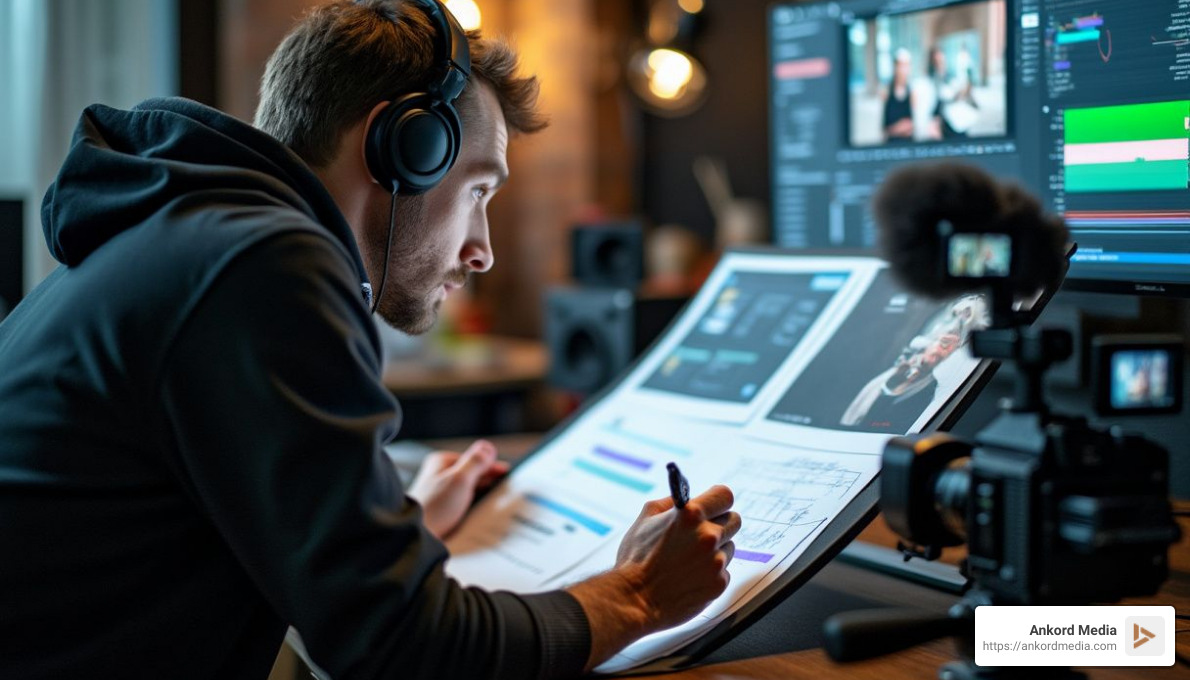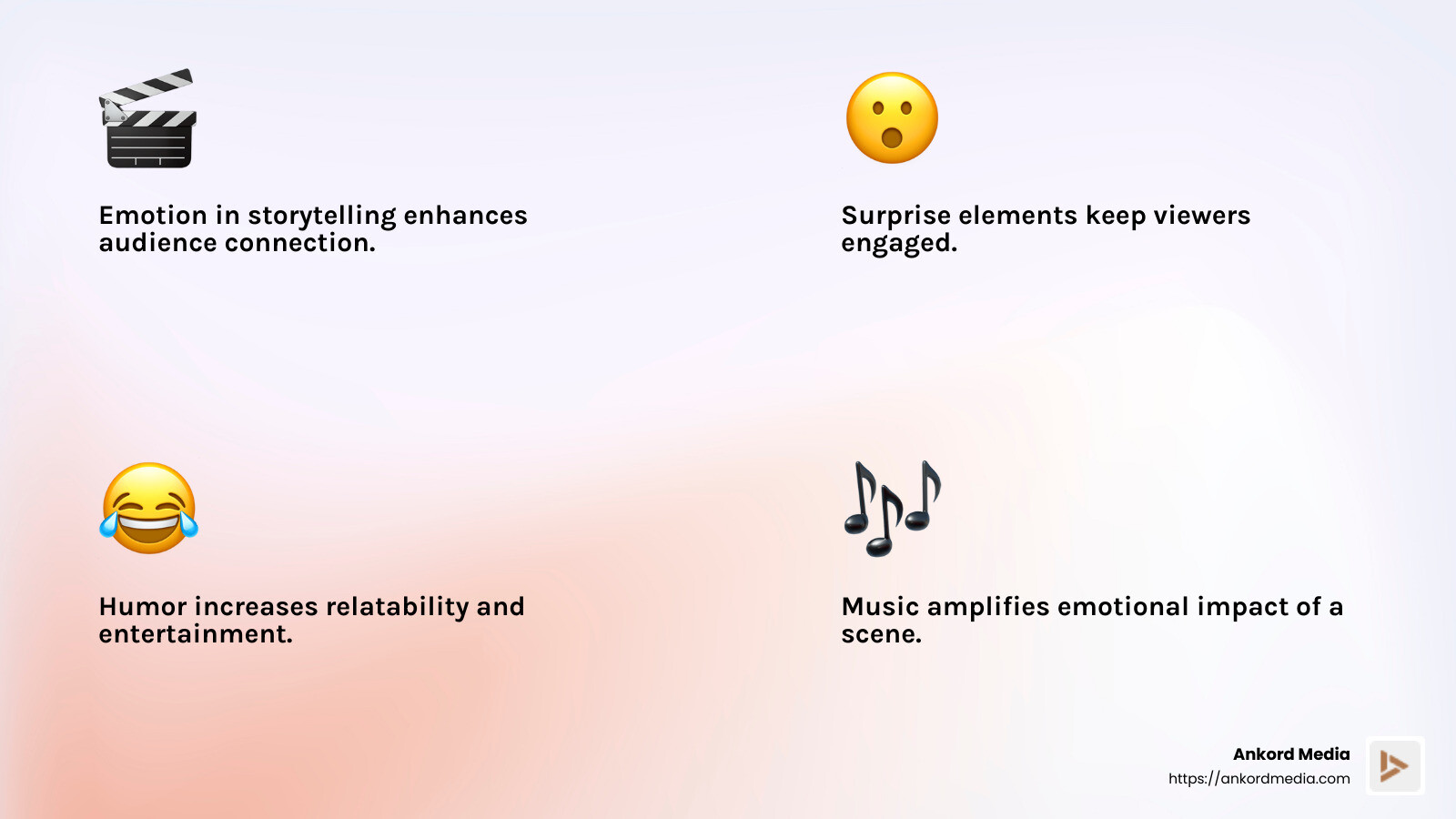From Script to Screen: Essential Storytelling Techniques for Digital Filmmakers

Storytelling techniques for digital filmmakers are the bridge between a raw idea and a visual masterpiece. Whether you're crafting an emotional journey or creating a thrilling plot twist, these techniques are the backbone of engaging digital films. Here's a quick look at the essentials:
- Clear Plot Structure: Organize your story into acts or chapters for clarity.
- Visuals: Use powerful imagery to convey messages.
- Emotional Hook: Connect with your audience on an emotional level.
- Innovative Methods: Incorporate unique techniques like animation or participatory segments to stand out.
Storytelling is more than just plot and structure—it's an art. In an age where attention spans are shrinking, every frame counts. Effective storytelling can captivate, educate, and resonate long after the credits roll. The right techniques can transform an idea into a compelling narrative that not only captures attention but also resonates deeply with audiences.
I'm Milan Kordestani, and I bring a blend of expertise in brand crafting and storytelling at the intersection of business and design. At Ankord Media, I help businesses harness storytelling techniques for digital filmmakers, ensuring their bold visions become memorable digital experiences.

The Art of Visual Storytelling
Visual storytelling is the heart of digital filmmaking. It transforms ideas into captivating narratives that grab the audience's attention and keep them engaged. In this section, we'll explore how visuals, immersive experiences, and VR Theater Programs can lift your storytelling.
The Power of Visuals
Visuals are not just about what you see; they're about what you feel. A well-crafted image can evoke emotions and convey complex messages without a single word. As Shaun MacGillivray, a renowned filmmaker, emphasizes, experimenting with the right images—both still and moving—is crucial. This approach allows filmmakers to create a narrative that resonates with viewers on a deeper level.
Immersive Experiences
Immersive storytelling takes audiences beyond the screen. It places them in the heart of the story, making them active participants rather than passive observers. Platforms like Vimeo's 360-degree video marketplace are leading the way by providing tools for creators to craft these immersive experiences. This technology allows viewers to explore scenes from different angles, adding a new dimension to storytelling.
VR Theater Programs
Virtual Reality (VR) is revolutionizing how stories are told. VR Theater Programs offer an unparalleled level of immersion, allowing audiences to experience stories in a fully interactive environment. This technology is not just for entertainment; it's a powerful tool for education and empathy-building.
Imagine walking through a historical event or stepping into a character's shoes. VR makes this possible, creating a memorable experience that traditional storytelling methods can't match. Vimeo's commitment to VR, with support for various headsets, highlights the growing demand for this innovative form of storytelling.
In conclusion, visual storytelling is more than just pretty pictures. It's about creating an experience that captivates and connects. By leveraging visuals, immersive experiences, and VR, digital filmmakers can craft stories that leave a lasting impact.
Storytelling Techniques for Digital Filmmakers
Creating a compelling story is at the core of successful digital filmmaking. To truly captivate your audience, master various storytelling techniques for digital filmmakers. Let's explore some of these techniques and how they can be applied effectively.
Plot Structure
A well-defined plot structure is the backbone of any great story. It guides the narrative flow, ensuring that each element of the story builds upon the last. Consider structuring your plot with a clear beginning, middle, and end, while allowing room for unexpected twists to keep your audience engaged. Using techniques like starting with the climax and then revealing the backstory can add intrigue and suspense.
Narration
Narration can be a powerful tool in storytelling. It offers an omniscient viewpoint that can provide context, background, and depth to the story. This technique is particularly effective in documentaries or films where the story's complexity requires additional explanation. Narration can be delivered in a traditional style, with an unseen narrator, or through a host who guides the audience through the story.
Host
A host can add a personal touch to your narrative. By appearing on camera, the host becomes a familiar face that connects with the audience. This technique is often used in travel documentaries or educational films, where the host's expertise or personal journey adds value to the story. The host's presence can make complex topics more relatable and engaging.
No Narration
Some stories are best told without words. The no narration technique relies on visuals, raw footage, and natural sound to convey the story. This approach allows the audience to interpret the events themselves, creating a more personal and immersive experience. It's a powerful method for capturing raw emotion and authenticity.
Recreations/Drama
When existing footage is lacking or events need dramatization, recreations or drama can fill in the gaps. This technique involves actors reenacting past events to bring them to life. It's often used in historical documentaries or films where the story requires a visual representation of events that were not captured on camera. This method can add a dramatic flair and emotional depth to your narrative.
By mastering these techniques, digital filmmakers can craft stories that resonate deeply with their audience. Whether it's through the strategic use of plot structure, the guiding voice of a narrator, or the immersive power of visuals, effective storytelling can transform a simple idea into a memorable experience.
Next, we'll explore how emotional engagement can lift your storytelling to new heights.
Emotional Engagement in Storytelling
Emotional engagement is the secret sauce that turns a good story into a memorable experience. For digital filmmakers, tapping into emotions is crucial for creating a connection with the audience. Let's explore some key elements that improve emotional storytelling.
Emotion
At the heart of every great story is emotion. Whether it's joy, sadness, fear, or excitement, emotions are what make stories relatable and impactful. Filmmakers can evoke emotions through character development, plot twists, and visual storytelling. For instance, a close-up shot of a character's face can convey a world of emotion, making the audience feel what the character is experiencing.
Surprise
Surprise your audience by introducing unexpected elements in your story. This could be a plot twist, an unexpected character, or a sudden change in the story's direction. As noted by filmmaker MacGillivray, surprising elements keep viewers on the edge of their seats and engaged with the narrative. For example, in a film about national parks, showcasing a lesser-known location like Michigan’s Pictured Rocks can add an element of surprise.
Humor
Humor is a powerful tool for engaging audiences. It can lighten the mood, make characters more relatable, and keep viewers entertained. Adding a touch of humor can be as simple as including a quirky character or a funny situation. In the National Parks movie, a prairie dog added the right amount of comedic relief, showing how humor can enrich storytelling.
Music
Music is the emotional backbone of a film. It sets the tone, improves the mood, and can even become a character in itself. A well-chosen soundtrack can amplify the emotional impact of a scene, making it unforgettable. As MacGillivray suggests, if the music hits you in the gut, you know you’ve got something special. Whether it's a suspenseful score during a tense moment or a joyful tune during a happy scene, music is essential for emotional storytelling.

By integrating these elements into your storytelling, you can create a powerful emotional connection with your audience. Emotions, surprise, humor, and music are not just tools—they are essential ingredients in the art of digital filmmaking. Next, we'll explore innovative storytelling methods that push the boundaries of traditional narratives.
Innovative Storytelling Methods
In digital filmmaking, innovation is key to captivating audiences. Here, we'll explore some storytelling techniques for digital filmmakers that are breaking new ground and offering fresh ways to tell stories.
Observational
Observational storytelling brings authenticity and a raw edge to films. By capturing real-life moments as they unfold, filmmakers can create a sense of immediacy and intimacy. A great example is the documentary "War Photographer," which uses tiny video cameras attached to the photographer's camera. This technique offers a “personal point of view” perspective, immersing viewers in the action and emotion of each shot.
Photo Slideshow
When words aren't enough, images can speak volumes. A photo slideshow is a creative way to narrate a story without relying on dialogue. This method can be particularly effective in sensitive narratives, such as stories involving trauma or privacy concerns. For example, using drawings or sketches to depict a character's journey, as seen in "Operation Homecoming - Writing the Wartime Experience," can convey powerful emotions while respecting the subject's anonymity.
Drawings/Animation
Drawings and animation open up limitless possibilities for storytelling. By segmenting a documentary into "chapters" or segments, each with its own title, filmmakers can guide viewers through complex narratives in a structured way. This technique not only simplifies storytelling but also adds a layer of artistic expression. Animation can bring imaginative worlds to life, making abstract concepts more accessible and engaging.
Chapters
Dividing a film into chapters is not just for books. This method can be particularly useful in educational or instructional documentaries. By breaking down the content into manageable sections, filmmakers can maintain audience interest and clarity. Each chapter can focus on a specific theme or task, encouraging viewers to engage actively with the material. This approach is akin to a "show and tell," where viewers are invited to participate in the story.
These innovative storytelling methods offer digital filmmakers new ways to connect with audiences. Whether through observational techniques, photo slideshows, drawings, or structured chapters, these methods can improve storytelling and push the boundaries of traditional narratives.

Next, we'll dive into frequently asked questions about storytelling techniques, providing clarity and insights for aspiring digital filmmakers.
Frequently Asked Questions about Storytelling Techniques
What are the key storytelling techniques for digital filmmakers?
Digital filmmakers have a wide array of techniques at their disposal to craft compelling narratives. Some of the most effective storytelling techniques for digital filmmakers include:
- Narration: This involves using a voiceover to guide the audience through the story. It's often used in documentaries to provide context and background information.
- Host: A visible guide or host leads the audience through the narrative. This can be particularly engaging in travel documentaries where the host shares personal experiences and insights.
- No Narration: Letting the visuals and natural sounds tell the story without a narrator. This technique is powerful in films where the imagery is strong enough to convey the message.
- Recreations/Drama: Dramatizing real events to fill in gaps where footage may not exist. This approach can be seen in historical documentaries, such as "Man on Wire."
These techniques allow filmmakers to choose the best method for their story, depending on the message they want to convey and the emotions they wish to evoke.
How can digital filmmakers emotionally connect with their audience?
Emotional connection is crucial in storytelling. Filmmakers can achieve this through several strategies:
- Surprise: Introducing unexpected elements keeps the audience engaged and curious. For instance, showcasing lesser-known locations alongside famous landmarks in a travel film can captivate viewers.
- Humor: A well-timed joke or funny scene can make a story memorable. In the National Parks film, a prairie dog provided comic relief, adding a light-hearted touch to the narrative.
- Music: The right soundtrack can evoke deep emotions. A song that resonates with the audience can improve the storytelling experience, making it more impactful.
By combining these elements, filmmakers can create stories that resonate on an emotional level, leaving a lasting impression on their audience.
What role does music play in storytelling for digital filmmakers?
Music is a powerful tool in storytelling. It sets the tone, improves emotions, and can even become a character in its own right. As filmmaker MacGillivray notes, "If the song moves you and it hits you in the gut, you've got something."
Music can:
- Set the Mood: A suspenseful track can build tension, while a soft melody can evoke nostalgia.
- Highlight Key Moments: A well-placed song can emphasize a pivotal scene, making it more memorable.
- Create Continuity: A recurring musical theme can tie different parts of the story together, providing a sense of cohesion.
In digital filmmaking, choosing the right music is as important as selecting the right visuals. It can transform a good story into a great one, leaving audiences emotionally fulfilled.
Next, we'll wrap up with a look at how Ankord Media leverages strategic branding and impactful storytelling to create unforgettable digital experiences.
Conclusion
At Ankord Media, we believe that impactful storytelling is at the heart of strategic branding. Our mission is to transform bold ideas into successful digital experiences that resonate with audiences and foster authentic connections.
Storytelling techniques for digital filmmakers are not just about capturing attention; they're about engaging emotions and leaving a lasting impression. By leveraging the power of visuals, music, and narrative techniques, we help our clients communicate their unique stories in a way that is both compelling and memorable.
Our approach combines cutting-edge design with strategic branding to ensure that every story we craft is aligned with our clients' values and objectives. Whether it's through immersive visuals or emotionally charged narratives, we strive to create experiences that not only captivate but also inspire.
Visit Ankord Media to find how we can help your brand tell its story with impact and authenticity. Let's turn your vision into reality.


